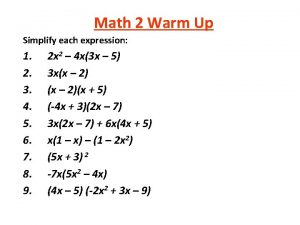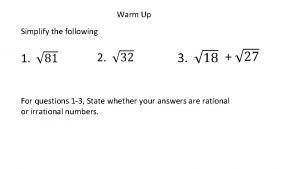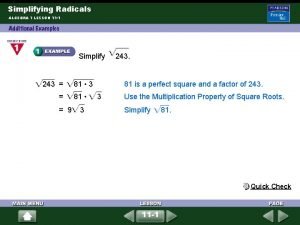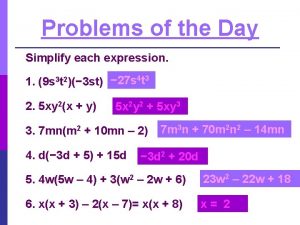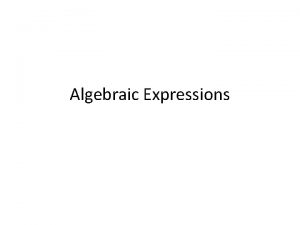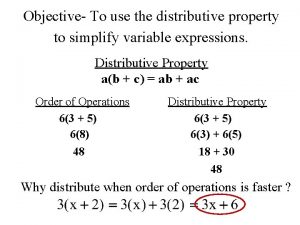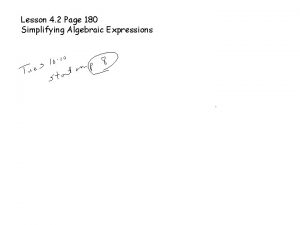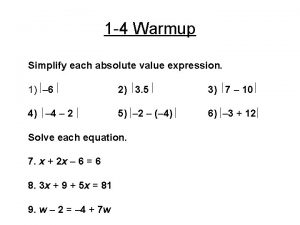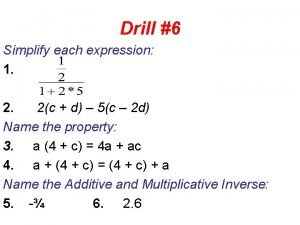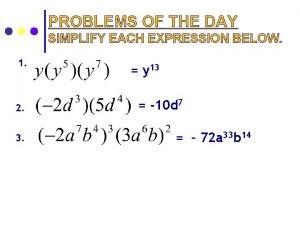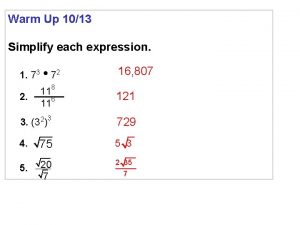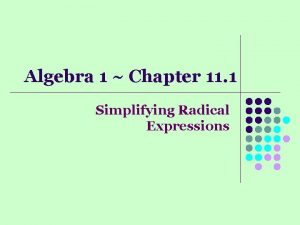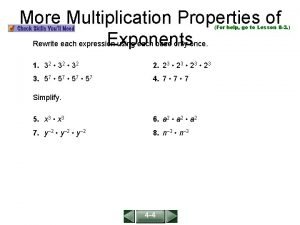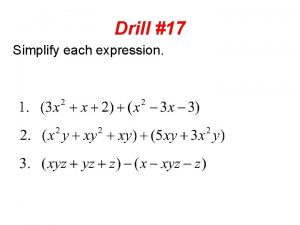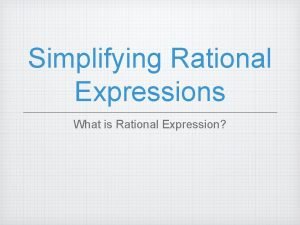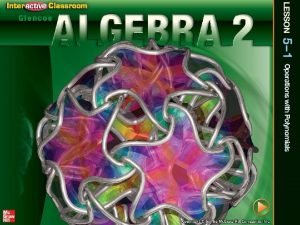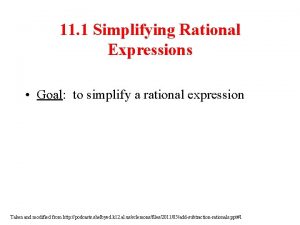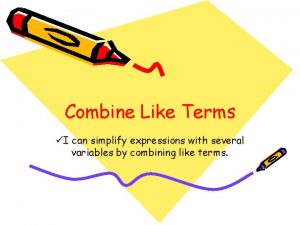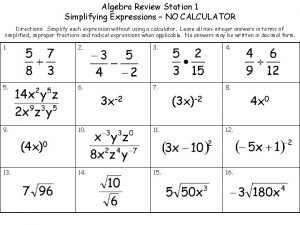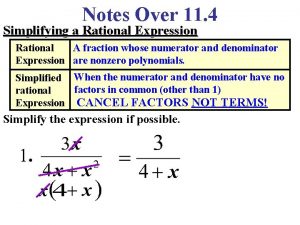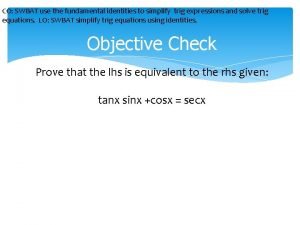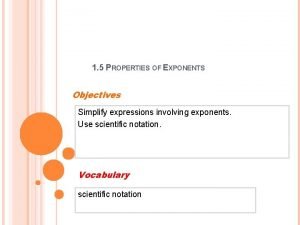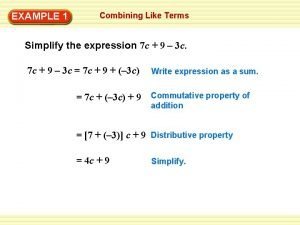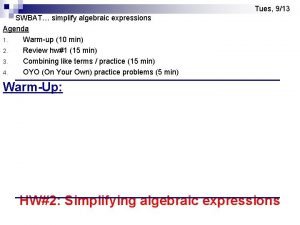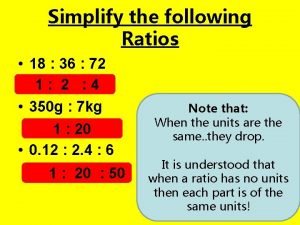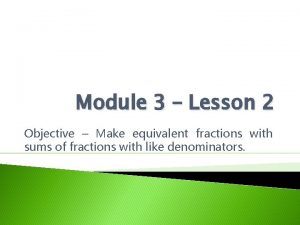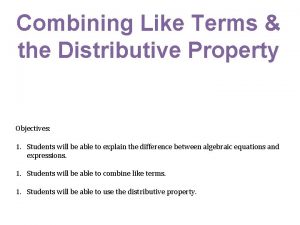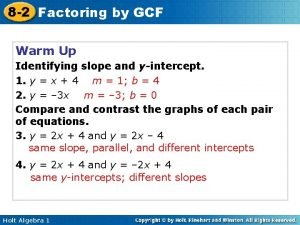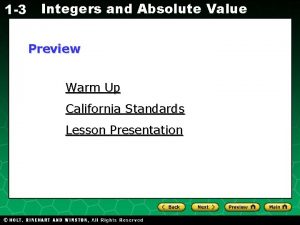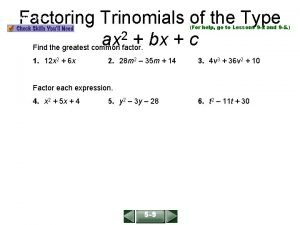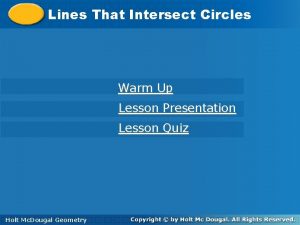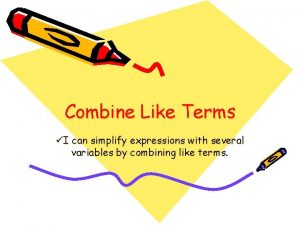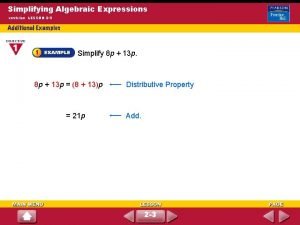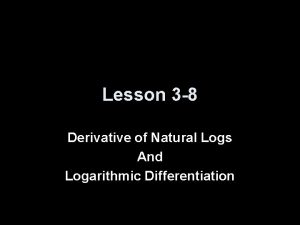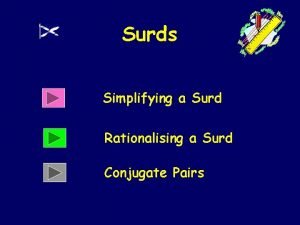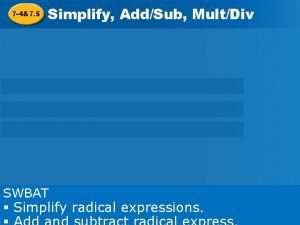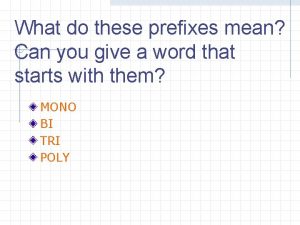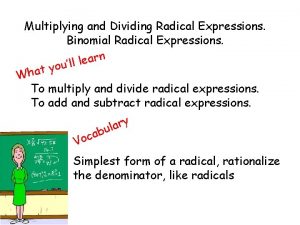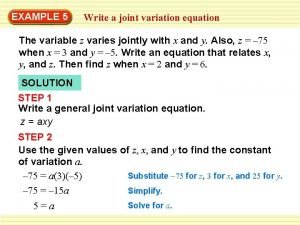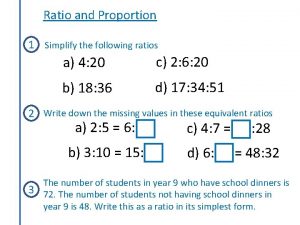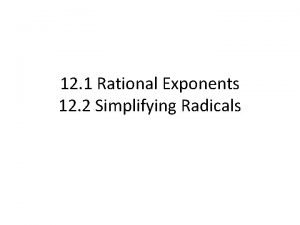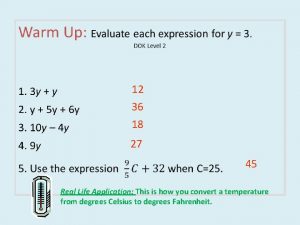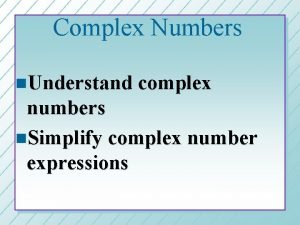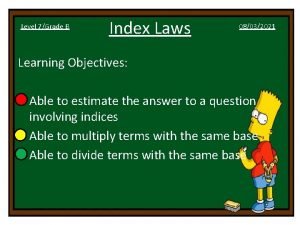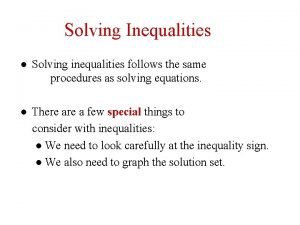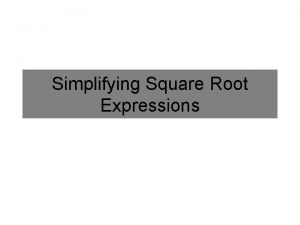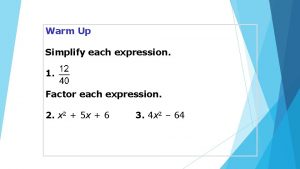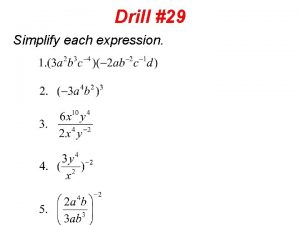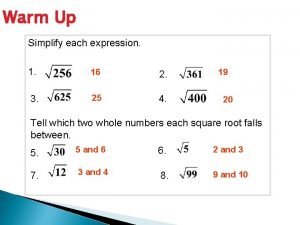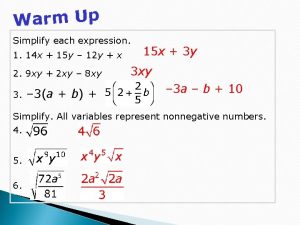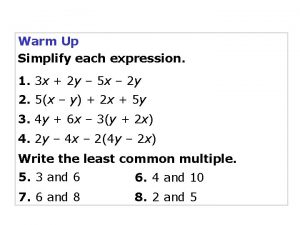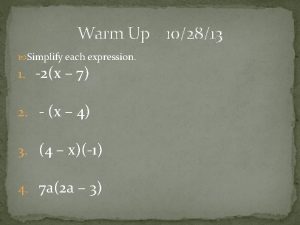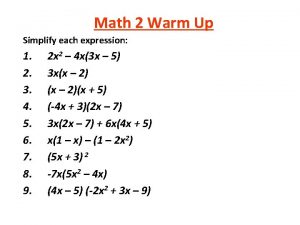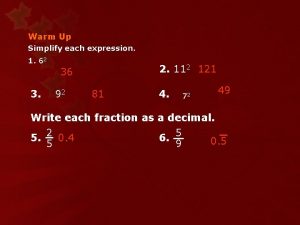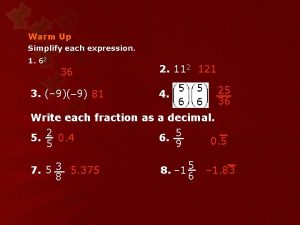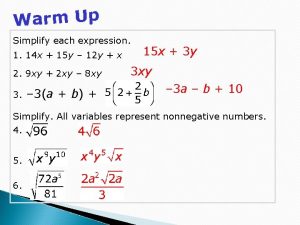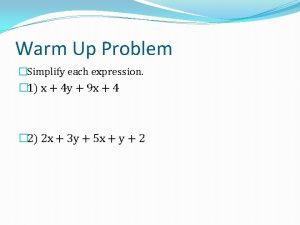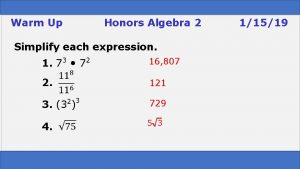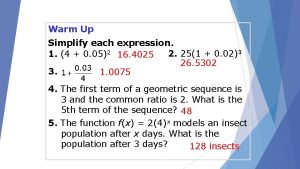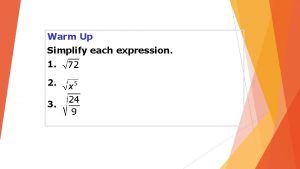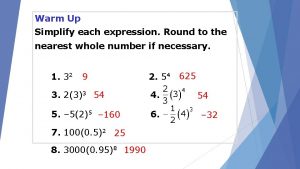Warm Up Simplify each expression 1 2 3












































































- Slides: 76

Warm Up Simplify each expression. 1. 2. 3. Find the zeros of each function. 4. f(x) = x 2 – 18 x + 16 5. f(x) = x 2 + 8 x – 24

Objectives Define and use imaginary and complex numbers. Solve quadratic equations with complex roots.

Vocabulary imaginary unit imaginary number complex number real part imaginary part complex conjugate

You can see in the graph of f(x) = x 2 + 1 below that f has no real zeros. If you solve the corresponding equation 0 = x 2 + 1, you find that x = , which has no real solutions. However, you can find solutions if you define the square root of negative numbers, which is why imaginary numbers were invented. The imaginary unit i is defined as. You can use the imaginary unit to write the square root of any negative number.


Example 1 A: Simplifying Square Roots of Negative Numbers Express the number in terms of i. Factor out – 1. Product Property. Simplify. Multiply. Express in terms of i.

Example 1 B: Simplifying Square Roots of Negative Numbers Express the number in terms of i. Factor out – 1. Product Property. Simplify. Express in terms of i.

Check It Out! Example 1 a Express the number in terms of i. Factor out – 1. Product Property. Simplify. Express in terms of i.

Check It Out! Example 1 b Express the number in terms of i. Factor out – 1. Product Property. Simplify. Multiply. Express in terms of i.

Check It Out! Example 1 c Express the number in terms of i. Factor out – 1. Product Property. Simplify. Multiply. Express in terms of i.

Example 2 A: Solving a Quadratic Equation with Imaginary Solutions Solve the equation. Take square roots. Express in terms of i. Check x 2 = – 144 (12 i)2 – 144 i 2 – 144(– 1) – 144 x 2 = (– 12 i)2 144 i 2 144(– 1) – 144

Example 2 B: Solving a Quadratic Equation with Imaginary Solutions Solve the equation. 5 x 2 + 90 = 0 Add – 90 to both sides. Divide both sides by 5. Take square roots. Express in terms of i. Check 5 x 2 + 90 = 0 0 5(18)i 2 +90 0 90(– 1) +90 0

Check It Out! Example 2 a Solve the equation. x 2 = – 36 Take square roots. Express in terms of i. Check x 2 = – 36 (6 i)2 36 i 2 36(– 1) – 36 x 2 = – 36 (– 6 i)2 – 36 36 i 2 – 36 36(– 1) – 36

Check It Out! Example 2 b Solve the equation. x 2 + 48 = 0 x 2 = – 48 Add – 48 to both sides. Take square roots. Express in terms of i. Check x 2 + 48 = + 48 (48)i 2 + 48 48(– 1) + 48 0 0

Check It Out! Example 2 c Solve the equation. 9 x 2 + 25 = 0 9 x 2 = – 25 Add – 25 to both sides. Divide both sides by 9. Take square roots. Express in terms of i.

A complex number is a number that can be written in the form a + bi, where a and b are real numbers and i=. The set of real numbers is a subset of the set of complex numbers C. Every complex number has a real part a and an imaginary part b.

Real numbers are complex numbers where b = 0. Imaginary numbers are complex numbers where a = 0 and b ≠ 0. These are sometimes called pure imaginary numbers. Two complex numbers are equal if and only if their real parts are equal and their imaginary parts are equal.

Example 3: Equating Two Complex Numbers Find the values of x and y that make the equation 4 x + 10 i = 2 – (4 y)i true. Real parts 4 x + 10 i = 2 – (4 y)i Imaginary parts 4 x = 2 Equate the real parts. Solve for x. 10 = – 4 y Equate the imaginary parts. Solve for y.

Check It Out! Example 3 a Find the values of x and y that make each equation true. 2 x – 6 i = – 8 + (20 y)i Real parts 2 x – 6 i = – 8 + (20 y)i Imaginary parts 2 x = – 8 Equate the real parts. x = – 4 Solve for x. – 6 = 20 y Equate the imaginary parts. Solve for y.

Check It Out! Example 3 b Find the values of x and y that make each equation true. – 8 + (6 y)i = 5 x – i Real parts – 8 + (6 y)i = 5 x – i Imaginary parts – 8 = 5 x Equate the real parts. Solve for x. Equate the imaginary parts. Solve for y.

Example 4 A: Finding Complex Zeros of Quadratic Functions Find the zeros of the function. f(x) = x 2 + 10 x + 26 = 0 Set equal to 0. x 2 + 10 x + Rewrite. = – 26 + x 2 + 10 x + 25 = – 26 + 25 (x + 5)2 = – 1 Add to both sides. Factor. Take square roots. Simplify.

Example 4 B: Finding Complex Zeros of Quadratic Functions Find the zeros of the function. g(x) = x 2 + 4 x + 12 = 0 Set equal to 0. x 2 + 4 x + Rewrite. = – 12 + x 2 + 4 x + 4 = – 12 + 4 (x + 2)2 = – 8 Add to both sides. Factor. Take square roots. Simplify.

Check It Out! Example 4 a Find the zeros of the function. f(x) = x 2 + 4 x + 13 = 0 Set equal to 0. x 2 + 4 x + Rewrite. = – 13 + x 2 + 4 x + 4 = – 13 + 4 (x + 2)2 = – 9 Add to both sides. Factor. Take square roots. x = – 2 ± 3 i Simplify.

Check It Out! Example 4 b Find the zeros of the function. g(x) = x 2 – 8 x + 18 = 0 Set equal to 0. x 2 – 8 x + Rewrite. = – 18 + x 2 – 8 x + 16 = – 18 + 16 Add to both sides. Factor. Take square roots. Simplify.

The solutions and are related. These solutions are a complex conjugate pair. Their real parts are equal and their imaginary parts are opposites. The complex conjugate of any complex number a + bi is the complex number a – bi. If a quadratic equation with real coefficients has nonreal roots, those roots are complex conjugates. Helpful Hint When given one complex root, you can always find the other by finding its conjugate.

Example 5: Finding Complex Zeros of Quadratic Functions Find each complex conjugate. B. 6 i A. 8 + 5 i 8 – 5 i Write as a + bi. Find a – bi. 0 + 6 i 0 – 6 i Write as a + bi. Find a – bi. Simplify.

Check It Out! Example 5 Find each complex conjugate. B. A. 9 – i 9 + (–i) Write as a + bi. 9 – (–i) 9+i Find a – bi. C. – 8 i 0 + (– 8)i 0 – (– 8)i 8 i Simplify. Write as a + bi. Find a – bi. Simplify.

Warm Up Express each number in terms of i. 1. 9 i 2. Find each complex conjugate. 3. 4. Find each product. 5. 6.

Objective Perform operations with complex numbers.

Vocabulary complex plane absolute value of a complex number

Just as you can represent real numbers graphically as points on a number line, you can represent complex numbers in a special coordinate plane. The complex plane is a set of coordinate axes in which the horizontal axis represents real numbers and the vertical axis represents imaginary numbers.

Helpful Hint The real axis corresponds to the x-axis, and the imaginary axis corresponds to the y-axis. Think of a + bi as x + yi.

Example 1: Graphing Complex Numbers Graph each complex number. A. 2 – 3 i – 1+ 4 i • B. – 1 + 4 i C. 4 + i D. –i 4+i • • –i • 2 – 3 i

Check It Out! Example 1 Graph each complex number. a. 3 + 0 i b. 2 i c. – 2 – i 2 i • – 2 – i d. 3 + 2 i • • 3 + 0 i

Recall that absolute value of a real number is its distance from 0 on the real axis, which is also a number line. Similarly, the absolute value of an imaginary number is its distance from 0 along the imaginary axis.

Example 2: Determining the Absolute Value of Complex Numbers Find each absolute value. A. |3 + 5 i| B. |– 13| C. |– 7 i| |– 13 + 0 i| |0 +(– 7)i| 13 7

Check It Out! Example 2 Find each absolute value. a. |1 – 2 i| b. c. |23 i| |0 + 23 i| 23

Adding and subtracting complex numbers is similar to adding and subtracting variable expressions with like terms. Simply combine the real parts, and combine the imaginary parts. The set of complex numbers has all the properties of the set of real numbers. So you can use the Commutative, Associative, and Distributive Properties to simplify complex number expressions.

Helpful Hint Complex numbers also have additive inverses. The additive inverse of a + bi is –(a + bi), or –a – bi.

Example 3 A: Adding and Subtracting Complex Numbers Add or subtract. Write the result in the form a + bi. (4 + 2 i) + (– 6 – 7 i) (4 – 6) + (2 i – 7 i) – 2 – 5 i Add real parts and imaginary parts.

Example 3 B: Adding and Subtracting Complex Numbers Add or subtract. Write the result in the form a + bi. (5 – 2 i) – (– 2 – 3 i) (5 – 2 i) + 2 + 3 i Distribute. (5 + 2) + (– 2 i + 3 i) Add real parts and imaginary parts. 7+i

Example 3 C: Adding and Subtracting Complex Numbers Add or subtract. Write the result in the form a + bi. (1 – 3 i) + (– 1 + 3 i) (1 – 1) + (– 3 i + 3 i) 0 Add real parts and imaginary parts.

Check It Out! Example 3 a Add or subtract. Write the result in the form a + bi. (– 3 + 5 i) + (– 6 i) (– 3) + (5 i – 6 i) – 3 – i Add real parts and imaginary parts.

Check It Out! Example 3 b Add or subtract. Write the result in the form a + bi. 2 i – (3 + 5 i) (2 i) – 3 – 5 i Distribute. (– 3) + (2 i – 5 i) Add real parts and imaginary parts. – 3 i

Check It Out! Example 3 c Add or subtract. Write the result in the form a + bi. (4 + 3 i) + (4 – 3 i) (4 + 4) + (3 i – 3 i) 8 Add real parts and imaginary parts.

You can also add complex numbers by using coordinate geometry.

Example 4: Adding Complex Numbers on the Complex Plane Find (3 – i) + (2 + 3 i) by graphing. Step 1 Graph 3 – i and 2 + 3 i on the complex plane. Connect each of these numbers to the origin with a line segment. 2 + 3 i • • 3 –i

Example 4 Continued Find (3 – i) + (2 + 3 i) by graphing. Step 2 Draw a parallelogram that has these two line segments as sides. The vertex that is opposite the origin represents the sum of the two complex numbers, 5 + 2 i. Therefore, (3 – i) + (2 + 3 i) = 5 + 2 i. 2 + 3 i • • • 3 –i 5 +2 i

Example 4 Continued Find (3 – i) + (2 + 3 i) by graphing. Check Add by combining the real parts and combining the imaginary parts. (3 – i) + (2 + 3 i) = (3 + 2) + (–i + 3 i) = 5 + 2 i

Check It Out! Example 4 a Find (3 + 4 i) + (1 – 3 i) by graphing. 3 + 4 i • Step 1 Graph 3 + 4 i and 1 – 3 i on the complex plane. Connect each of these numbers to the origin with a line segment. • 1 – 3 i

Check It Out! Example 4 a Continued Find (3 + 4 i) + (1 – 3 i) by graphing. Step 2 Draw a parallelogram that has these two line segments as sides. The vertex that is opposite the origin represents the sum of the two complex numbers, 4 + i. Therefore, (3 + 4 i) + (1 – 3 i) = 4 + i. 3 + 4 i • • • 1 – 3 i 4+i

Check It Out! Example 4 a Continued Find (3 + 4 i) + (1 – 3 i) by graphing. Check Add by combining the real parts and combining the imaginary parts. (3 + 4 i) + (1 – 3 i) = (3 + 1) + (4 i – 3 i) = 4 + i

Check It Out! Example 4 b Find (– 4 – i) + (2 – 2 i) by graphing. Step 1 Graph – 4 – i and 2 – 2 i on the complex plane. Connect each of these numbers to the origin with a line segment. – 4 – i • 2 – 2 i • ● 2 – 2 i

Check It Out! Example 4 b Find (– 4 – i) + (2 – 2 i) by graphing. Step 2 Draw a parallelogram that has these two line segments as sides. The vertex that is opposite represents the sum of the two complex numbers, – 2 – 3 i. Therefore, (– 4 – i) + (2 – 2 i) = – 2 – 3 i. – 4 – i • • – 2 – 3 i • 2 – 2 i

Check It Out! Example 4 b Find (– 4 – i) + (2 – 2 i) by graphing. Check Add by combining the real parts and combining the imaginary parts. (– 4 – i) + (2 – 2 i) = (– 4 + 2) + (–i – 2 i) = – 2 – 3 i

You can multiply complex numbers by using the Distributive Property and treating the imaginary parts as like terms. Simplify by using the fact i 2 = – 1.

Example 5 A: Multiplying Complex Numbers Multiply. Write the result in the form a + bi. – 2 i(2 – 4 i) – 4 i + 8 i 2 Distribute. – 4 i + 8(– 1) Use i 2 = – 1. – 8 – 4 i Write in a + bi form.

Example 5 B: Multiplying Complex Numbers Multiply. Write the result in the form a + bi. (3 + 6 i)(4 – i) 12 + 24 i – 3 i – 6 i 2 Multiply. 12 + 21 i – 6(– 1) Use i 2 = – 1. 18 + 21 i Write in a + bi form.

Example 5 C: Multiplying Complex Numbers Multiply. Write the result in the form a + bi. (2 + 9 i)(2 – 9 i) 4 – 18 i + 18 i – 81 i 2 Multiply. 4 – 81(– 1) Use i 2 = – 1. 85 Write in a + bi form.

Example 5 D: Multiplying Complex Numbers Multiply. Write the result in the form a + bi. (– 5 i)(6 i) – 30 i 2 Multiply. – 30(– 1) Use i 2 = – 1 30 Write in a + bi form.

Check It Out! Example 5 a Multiply. Write the result in the form a + bi. 2 i(3 – 5 i) 6 i – 10 i 2 Distribute. 6 i – 10(– 1) Use i 2 = – 1. 10 + 6 i Write in a + bi form.

Check It Out! Example 5 b Multiply. Write the result in the form a + bi. (4 – 4 i)(6 – i) 24 – 4 i – 24 i + 4 i 2 Distribute. 24 – 28 i + 4(– 1) Use i 2 = – 1. 20 – 28 i Write in a + bi form.

Check It Out! Example 5 c Multiply. Write the result in the form a + bi. (3 + 2 i)(3 – 2 i) 9 + 6 i – 4 i 2 Distribute. 9 – 4(– 1) Use i 2 = – 1. 13 Write in a + bi form.

The imaginary unit i can be raised to higher powers as shown below. Helpful Hint Notice the repeating pattern in each row of the table. The pattern allows you to express any power of i as one of four possible values: i, – 1, –i, or 1.

Example 6 A: Evaluating Powers of i Simplify – 6 i 14 = – 6(i 2)7 Rewrite i 14 as a power of i 2. = – 6(– 1)7 = – 6(– 1) = 6 Simplify.

Example 6 B: Evaluating Powers of i Simplify i 63 = i i 62 = i (i 2)31 Rewrite as a product of i and an even power of i. Rewrite i 62 as a power of i 2. = i (– 1)31 = i – 1 = –i Simplify.

Check It Out! Example 6 a Simplify . Rewrite as a product of i and an even power of i. Rewrite i 6 as a power of i 2. Simplify.

Check It Out! Example 6 b Simplify i 42 = ( i 2)21 = (– 1)21 = – 1 Rewrite i 42 as a power of i 2. Simplify.

Recall that expressions in simplest form cannot have square roots in the denominator (Lesson 1 -3). Because the imaginary unit represents a square root, you must rationalize any denominator that contains an imaginary unit. To do this, multiply the numerator and denominator by the complex conjugate of the denominator. Helpful Hint The complex conjugate of a complex number a + bi is a – bi. (Lesson 5 -5)

Example 7 A: Dividing Complex Numbers Simplify. Multiply by the conjugate. Distribute. Use i 2 = – 1. Simplify.

Example 7 B: Dividing Complex Numbers Simplify. Multiply by the conjugate. Distribute. Use i 2 = – 1. Simplify.

Check It Out! Example 7 a Simplify. Multiply by the conjugate. Distribute. Use i 2 = – 1. Simplify.

Check It Out! Example 7 b Simplify. Multiply by the conjugate. Distribute. Use i 2 = – 1. Simplify.

Lesson Quiz: Part I Graph each complex number. 1. – 3 + 2 i 2. 4 – 2 i – 3 + 2 i • 4 – 2 i •

Lesson Quiz: Part II 3. Find |7 + 3 i|. Perform the indicated operation. Write the result in the form a + bi. 4. (2 + 4 i) + (– 6 – 4 i) – 4 5. (5 – i) – (8 – 2 i) – 3 + i 6. (2 + 5 i)(3 – 2 i) 16 + 11 i 7. 8. Simplify i 31. –i 3+i

Lesson Quiz 1. Express in terms of i. Solve each equation. 2. 3 x 2 + 96 = 0 3. x 2 + 8 x +20 = 0 4. Find the values of x and y that make the equation 3 x +8 i = 12 – (12 y)i true. 5. Find the complex conjugate of
 Simplify each expression
Simplify each expression For questions 1–2, simplify each expression.
For questions 1–2, simplify each expression. Simplifying radicals worksheet algebra 1
Simplifying radicals worksheet algebra 1 Simplify each expression
Simplify each expression Simplify each expression
Simplify each expression Simplify each expression using the distributive property
Simplify each expression using the distributive property Simplify each expression.
Simplify each expression. Describe how to simplify the expression .
Describe how to simplify the expression . How to simplify absolute value with variables
How to simplify absolute value with variables Constant number example
Constant number example Simplify each expression and then arrange them in
Simplify each expression and then arrange them in Simplify each expression.
Simplify each expression. Simplify each radical expression
Simplify each radical expression More multiplication properties of exponents
More multiplication properties of exponents Simplify the expression.
Simplify the expression. Simplifying regular expressions
Simplifying regular expressions Simplify the expression
Simplify the expression Simplify rational expression
Simplify rational expression Combine like terms examples
Combine like terms examples Simplify expression calculator
Simplify expression calculator Simplify the expression where possible.
Simplify the expression where possible. K map
K map Use the fundamental identities to simplify the expression
Use the fundamental identities to simplify the expression Evaluate expressions using properties of exponents
Evaluate expressions using properties of exponents Whats a constant term
Whats a constant term Simplify the following trigonometric expression
Simplify the following trigonometric expression Simplify the expression
Simplify the expression Simplify expressions with distribution
Simplify expressions with distribution Boolean expression
Boolean expression What is 18/36 simplified
What is 18/36 simplified Quadratic formula examples
Quadratic formula examples Special cases of factoring
Special cases of factoring Show each expression on a number line
Show each expression on a number line Combining like terms lesson
Combining like terms lesson 8-2 factoring by gcf
8-2 factoring by gcf Evaluate each expression integers
Evaluate each expression integers Factoring each expression
Factoring each expression Factor each expression
Factor each expression State the excluded values for each rational expression
State the excluded values for each rational expression Phrasal verbs choose the correct preposition
Phrasal verbs choose the correct preposition Identify each line or segment that intersects each circle
Identify each line or segment that intersects each circle Simplify expressions by combining like terms
Simplify expressions by combining like terms Unit 7 lesson 2 simplify expressions
Unit 7 lesson 2 simplify expressions Unit production in automata
Unit production in automata Square root 48 simplified
Square root 48 simplified Simplify 12 square root
Simplify 12 square root Ln derivative
Ln derivative Surds conjugate
Surds conjugate Simplify
Simplify Simplify radicals with x (mc)
Simplify radicals with x (mc) Scientific notation simplify calculator
Scientific notation simplify calculator Simplify compliance llc
Simplify compliance llc How to multiply complex numbers
How to multiply complex numbers Simplify.4x5+x6xx+2
Simplify.4x5+x6xx+2 Simplify payables
Simplify payables Simplifying nonperfect roots quiz
Simplifying nonperfect roots quiz Binomial radical expressions
Binomial radical expressions Joint variation math
Joint variation math Simplify 7gh x 3g2 x 5h
Simplify 7gh x 3g2 x 5h Simplifying perfect squares
Simplifying perfect squares Grid method expanding double brackets
Grid method expanding double brackets Simplify the following ratios
Simplify the following ratios Simplify na cl
Simplify na cl Rational exponent theorem
Rational exponent theorem Simplify 27/45
Simplify 27/45 Simplify complex numbers
Simplify complex numbers 7 index laws
7 index laws X3 = 64/343
X3 = 64/343 Cancel these ratios
Cancel these ratios Simplify chemical equations
Simplify chemical equations How to simplify mixed numbers
How to simplify mixed numbers Simplifying expressions by combining like terms
Simplifying expressions by combining like terms How to solve inequality
How to solve inequality Exponent
Exponent Square root multiplied by square root
Square root multiplied by square root Hro principles
Hro principles Dmca square root
Dmca square root
